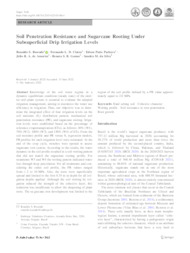Soil penetration resistance and Sugarcane rooting under subsuperficial drip irrigation levels.
Soil penetration resistance and Sugarcane rooting under subsuperficial drip irrigation levels.
Author(s): RESENDE, R. S.; CINTRA, F. L. D.; PACHECO, E. P.; AMORIM, J. R. A. de; BRANT, R. da S.; SILVA, S. M. da
Summary: Knowledge of the soil water regime in a dynamic equilibrium condition (steady state) of the emitter?soil?plant system is essential to evaluate the adopted irrigation management, aiming to maximize the water use efficiency in irrigation. Thus, our objective was to determine the integrated effect of four irrigation levels on the soil moisture (θv) distribution pattern, mechanical soil penetration resistance (PR), and sugarcane rooting. Irrigation levels were established based on the percentage of reference evapotranspiration (ETo), as follows: 40% (W1), 70% (W2), 100% (W3), and 130% (W4) of ETo. From the soil moisture profile and PR versus θv regression models, PR profiles for each irrigation level were estimated. At the end of the crop cycle, trenches were opened to assess sugarcane root system. According to the results, the water dynamic in the soil profile resulted in a soil-wetting pattern that did not match the sugarcane rooting profile. For treatments W3 and W4 the wetting pattern indicated water loss through deep percolation. For all treatments and considering the entire soil profile, the PR values ranged from < 2 to 10 MPa. Also, the roots were superficially spread and limited to the first 0.35 m in depth for all irrigation depths applied. Although the soil wetting by irrigation reduced the strength of the cohesive layer, this reduction was insufficient to allow the deepening of plant roots. The su garcane root development was limited to the region of the soil profile defined by a PR value approximately equal to 2.0 MPa.
Publication year: 2022
Types of publication: Journal article
Observation
Some of Embrapa's publications are published as ePub files. To read them, use or download one of the following free software options to your computer or mobile device. Android: Google Play Books; IOS: iBooks; Windows and Linux: Calibre.
Access other publications
Access the Agricultural Research Database (BDPA) to consult Embrapa's full library collection and records.
Visit Embrapa Bookstore to purchase books and other publications sold by Embrapa.

